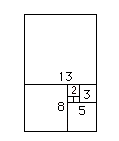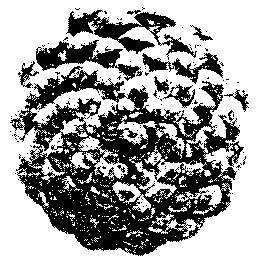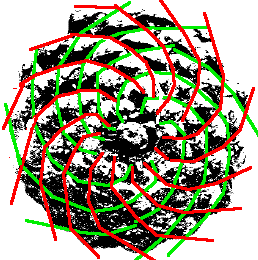Fibonacci's Rabbits
- The original problem that
Fibonacci investigated (in the year 1202) was about how fast rabbits could
breed in ideal circumstances.
- At the end of the first month, they mate, but there is still one only 1 pair.
- At the end of the second month the female produces a new pair, so now there are 2 pairs of rabbits in the field.
- At the end of the third month, the original female produces a second pair, making 3 pairs in all in the field.
- At the end of the fourth month, the original female has produced yet another new pair, the female born two months ago produces her first pair also, making 5 pairs.
Suppose a newly-born pair of rabbits, one male, one female, are put in a field. Rabbits are able to mate at the age of one month so that at the end of its second month a female can produce another pair of rabbits. Suppose that our rabbits never die and that the female always produces one new pair (one male, one female) every month from the second month on. The puzzle that Fibonacci posed was...
How many pairs will there be in one year?
Bees, Fibonacci numbers and
Family trees
- The Bee Family Tree shows
the Fibonacci numbers. First, some unusual facts about bees such as: not
all of them have two parents!
- He had 1 parent, a female.
- He has 2 grand-parents, since his mother had two parents, a male and a female.
- He has 3 great-grand-parents: his grand-mother had two parents but his grand-father had only one.
- How many great-great-grand parents did he have?
Males are produced by the queen's unfertilised eggs, so male bees only have a mother but no father!
So female bees have 2 parents, a male and a female whereas male bees have just one parent, a female.
Here we follow the convention of Family Trees that parents appear above their children, so the latest generations are at the bottom and the higher up we go, the older people are. Such trees show all the ancestors (predecessors, forebears, antecedents) of the person at the bottom of the diagram. We would get quite a different tree if we listed all the descendants (progeny, offspring) of a person as we did in the rabbit problem, where we showed all the descendants of the original pair.
great- great,great gt,gt,gt
grand- grand- grand grand
Number of parents: parents: parents: parents: parents:
of a MALE bee: 1 2 3 5 8
of a FEMALE bee: 2 3 5 8 13
The Fibonacci Rectangles and
Shell Spirals


We can make another picture showing the Fibonacci numbers 1,1,2,3,5,8,13,21,.. if we start with two small squares of size 1 next to each other. On top of both of these draw a square of size 2 (=1+1).
We can now draw a new square - touching both a unit square and the latest square of side 2 - so having sides 3 units long; and then another touching both the 2-square and the 3-square (which has sides of 5 units). We can continue adding squares around the picture, each new square having a side which is as long as the sum of the latest two square's sides. This set of rectangles whose sides are two successive Fibonacci numbers in length and which are composed of squares with sides which are Fibonacci numbers, we will call the Fibonacci Rectangles.

The next diagram shows that
we can draw a spiral by putting together quarter circles, one in each new
square. This is a spiral (the Fibonacci Spiral) which is very close
to the one that occurs in nature as the shape of a snail shell or some
sea shells.
Click on the shell picture
(a slice through a Nautilus shell) to expand it.
These spiral shapes are called Equiangular or Logarithmic spirals. The links from these terms contain much more information on these curves and pictures of computer-generated shells.
Fibonacci Numbers and Branching
Plants
One plant in particular shows the Fibonacci numbers in the number of "growing points" that it has. Suppose that when a plant puts out a new shoot, that shoot has to grow two months before it is strong enough to support branching. If it branches every month after that at the growing point, we get the picture shown here.
A plant that grows very much like this is the "sneezewort": Achillea ptarmica.
Petals on flowers
On many plants, the number of
petals is a Fibonacci number:
buttercups have 5 petals; lilies and iris have 3 petals; some delphiniums have 8; corn marigolds have 13 petals; some asters have 21 whereas daisies can be found with 34, 55 or even 89 petals.
3 petals: lily , iris
Often lilies have 6 petals formed from two sets of 3.
5 petals: buttercup,
wild rose, larkspur, columbine (aquilegia)
The humble buttercup has been bred into a multi-petalled form.
8 petals: delphiniums
13 petals: ragwort,
corn marigold, cineraria,
21 petals: aster,
black-eyed susan, chicory
34 petals: plantain,
pyrethrum
55, 89 petals: michelmas
daisies, the asteraceae family
Some species are very precise
about the number of petals they have - eg buttercups, but others have petals
that are very near those above, with the average being a Fibonacci number.
Pine cones


Pine cones show the Fibonacci Spirals clearly. Here is a picture of a pinecone seen from its base and another with the spirals emphasised: red in one direction and green in the other.
Why do the Golden section and
Fibonacci numbers appear in nature?
- The reason seems to be the
same for the arrangements of leaves as for seeds and petals. All are placed
at about 0.618034 leaves, (seeds, petals) per turn in one direction which
is the same as 1 0.618034 = 0.381966 leaves per turn in the other.
If there are Phi (1.618...) leaves per turn (or, equivalently, phi=0.618...
turns per leaf ), then we have the best packing so that each leaf gets
the maximum exposure to light, casting the least shadow on the others.
This also gives the best possible area exposed to falling rain so the rain
is directed back along the leaf and down the stem to the roots. For flowers
or petals, it gives the best possible exposure to insects to attract them
for pollination.
The whole of the plant seems to produce its leaves, flowerhead petals and then seeds based upon the golden number.
The Fibonacci numbers form the best whole number approximations to the golden number.
Fibonacci Fingers?
- Look at your own hand:

- 2 hands each of which has ...
- 5 fingers, each of which has ...
- 3 parts separated by ...
- 2 knuckles
- You have ...
However, if you measure the lengths of the bones in your finger (best seen by slightly bending the finger) does it look as if the ratio of the longest bone in a finger to the middle bone is Phi?
What about the ratio of the middle bone to the shortest bone (at the end of the finger) - Phi again?
Can you find any ratios in the lengths of the fingers that looks like Phi? ---or does it look as if it could be any other similar ratio also?
Why not measure your friends' hands and gather some statistics?